葡萄牙英文简介课件
- 格式:ppt
- 大小:3.87 MB
- 文档页数:4


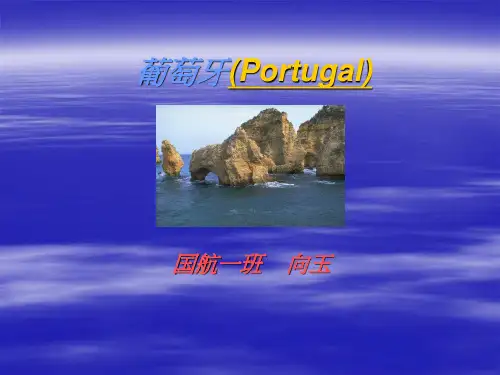

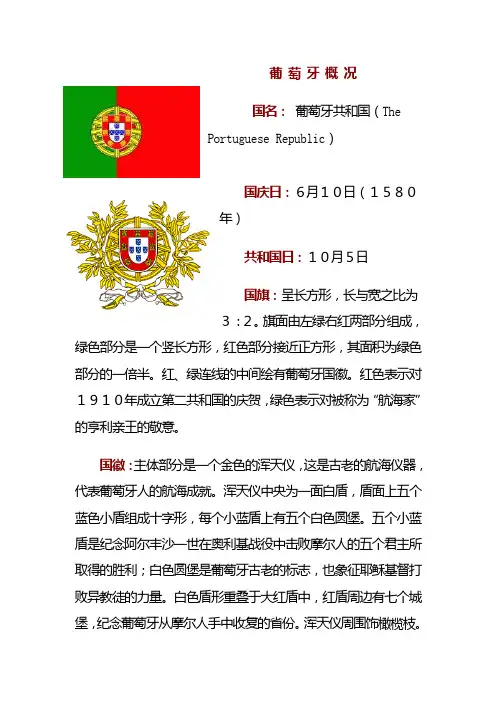
葡萄牙概况国名:葡萄牙共和国(ThePortuguese Republic)国庆日:6月10日(1580年)共和国日:10月5日国旗:呈长方形,长与宽之比为3:2。
旗面由左绿右红两部分组成,绿色部分是一个竖长方形,红色部分接近正方形,其面积为绿色部分的一倍半。
红、绿连线的中间绘有葡萄牙国徽。
红色表示对1910年成立第二共和国的庆贺,绿色表示对被称为“航海家”的亨利亲王的敬意。
国徽:主体部分是一个金色的浑天仪,这是古老的航海仪器,代表葡萄牙人的航海成就。
浑天仪中央为一面白盾,盾面上五个蓝色小盾组成十字形,每个小蓝盾上有五个白色圆堡。
五个小蓝盾是纪念阿尔丰沙一世在奥利基战役中击败摩尔人的五个君主所取得的胜利;白色圆堡是葡萄牙古老的标志,也象征耶稣基督打败异教徒的力量。
白色盾形重叠于大红盾中,红盾周边有七个城堡,纪念葡萄牙从摩尔人手中收复的省份。
浑天仪周围饰橄榄枝。
国花:薰衣草国家政要:总统若热〃桑帕约(Jorge Sampaio ),1996年3月就职,2001年1月蝉联;总理若泽〃曼努埃尔〃杜朗〃巴罗佐(JoseManuel Durao Barroso),2002年4月任职。
自然地理:面积为92072平方公里。
其中大陆面积88941平方公里,亚速海位于欧洲伊比利亚半岛西南部。
东、北与西班牙毗邻,西南濒临大西洋。
海岸线长800多公里。
地形北高南低,多为山地和丘陵。
北部是梅塞塔高原;中部山区平均海拔800~1000米,埃什特雷拉峰海拔1991米;南部和西部分别为丘陵和沿海平原。
主要河流有特茹河、杜罗河(流经境内322公里)和蒙特古河。
北部属海洋性温带阔叶林气候,南部属亚热带地中海式气候。
平均气温1月7~11℃,7月20~26℃。
年平均降水量500~1000毫米。
人口:1031. 8万(2001年)。
其中99%以上为葡萄牙人,其余为西班牙人等。
官方语言为葡萄牙语。
97%以上居民信奉天主教。
首都:里斯本(lisbon),人口53. 5万(1999年),全年平均气温16. 9℃,最高气温37. 2℃(7月),最低气温2. 1℃(1月)。

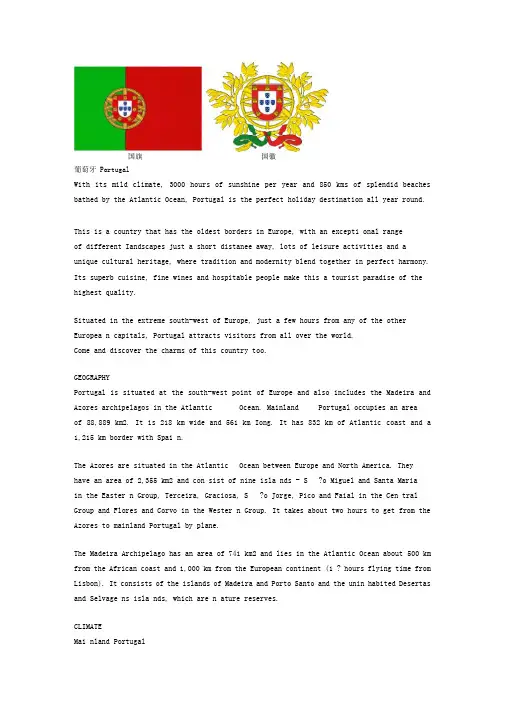
国旗国徽葡萄牙 PortugalWith its mild climate, 3000 hours of sunshine per year and 850 kms of splendid beaches bathed by the Atlantic Ocean, Portugal is the perfect holiday destination all year round.This is a country that has the oldest borders in Europe, with an excepti onal rangeof different Iandscapes just a short distanee away, lots of leisure activities and a unique cultural heritage, where tradition and modernity blend together in perfect harmony. Its superb cuisine, fine wines and hospitable people make this a tourist paradise of the highest quality.Situated in the extreme south-west of Europe, just a few hours from any of the other Europea n capitals, Portugal attracts visitors from all over the world.Come and discover the charms of this country too.GEOGRAPHYPortugal is situated at the south-west point of Europe and also includes the Madeira and Azores archipelagos in the Atlantic Ocean. Mainland Portugal occupies an areaof 88,889 km2. It is 218 km wide and 561 km Iong. It has 832 km of Atlantic coast and a 1,215 km border with Spai n.The Azores are situated in the Atlantic Ocean between Europe and North America. They have an area of 2,355 km2 and con sist of nine isla nds - S ?o Miguel and Santa Mariain the Easter n Group, Terceira, Graciosa, S ?o Jorge, Pico and Faial in the Cen tral Group and Flores and Corvo in the Wester n Group. It takes about two hours to get from the Azores to mainland Portugal by plane.The Madeira Archipelago has an area of 741 km2 and lies in the Atlantic Ocean about 500 km from the African coast and 1,000 km from the European continent (1 ? hours flying time from Lisbon). It consists of the islands of Madeira and Porto Santo and the unin habited Desertas and Selvage ns isla nds, which are n ature reserves.CLIMATEMai nland PortugalThe climate in Portugal varies con siderably from one regi on to ano ther and is in flue need by the relief, latitude and proximity to the sea, which offers mildwinters, especially in the Algarve.In the Porto e Norte area and Beiras region, particularly inland, nearer Spain, the winters are colder, although the temperatures are still mild when compared to the rest of Europe. There is some snowfall. It occurs most in the Serra da Estrela mountains, where we find the highest point in mainland Portugal (1,991 m) and where it is sometimes possible to ski.The summers are hot and dry, especially in the in la nd areas (Tr cs-os-M on tes in north-eastern Portugal and Alentejo). Temperatures are slightly lower in the coastal areas, because of the influence of the sea.There are often warm, sunny days in autumn. Nice weather at the beginning of November is often called "St. Martin 's Summer" as this saint 's day is on 11 November.AzoresThe climate in the Azores is influenced by the islands 'latitude and by the Gulf Stream, and temperatures are mild there all year round. The same factors also influence the sea temperature, which is very pleasant both in winter and summer and ideal for nautical sports all year round.MadeiraThe subtropical characteristics of the weather in the Madeira Archipelago can be explained by its geographical position and mountainous relief. The climate in Madeira is exceptionally mild, with average temperatures varying between 24 oC in summer and 19 oC in winter.The sea temperature is also very pleasant all year round, thanks to the influenceof the warm Gulf Stream. It varies between 18 oC in winter and 22 oC in summer.POPULATIONPortugal has a population of about 10 million.The population density is at its greatest in Lisbon, the capital and its suburbs,where about 1.9 million people live. The second largest city in Portugal is Oporto in the north.Generally speaking, there are more people living in the country 's coastal regions than in the inland areas.LANGUAGEFrom a Latin root, Portuguese is spoken by about 250 million people in every continent, and is the 5th most spoken language in the world and the 3rd, if we only consider the European languages.The Portuguese-speaking countries are scattered all over the world. Portuguese isspoke n in Africa (An gola, Cape Verde, Guin ea-Bissau, Mozambique and S ?o Tom e ePr n cipe), in South America (Brazil) and in Asia, (East Timor, the youngest nation in theworld), and it is also the official language in Macao Special Region of China.In Portugal there are lots of people who are able to communicate in and Spanish.Administrative English, French欢迎您的下载,资料仅供参考!致力为企业和个人提供合同协议,策划案计划书,学习资料等等打造全网一站式需求。
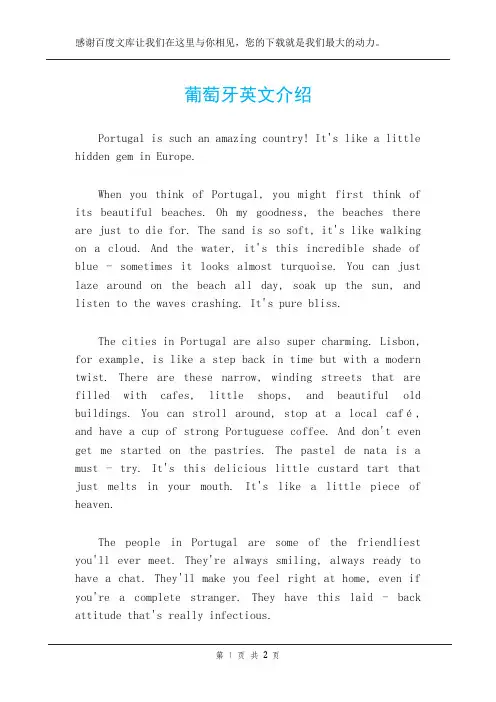
葡萄牙英文介绍Portugal is such an amazing country! It's like a little hidden gem in Europe.When you think of Portugal, you might first think of its beautiful beaches. Oh my goodness, the beaches there are just to die for. The sand is so soft, it's like walking on a cloud. And the water, it's this incredible shade of blue - sometimes it looks almost turquoise. You can just laze around on the beach all day, soak up the sun, and listen to the waves crashing. It's pure bliss.The cities in Portugal are also super charming. Lisbon, for example, is like a step back in time but with a modern twist. There are these narrow, winding streets that are filled with cafes, little shops, and beautiful old buildings. You can stroll around, stop at a local café, and have a cup of strong Portuguese coffee. And don't even get me started on the pastries. The pastel de nata is a must - try. It's this delicious little custard tart that just melts in your mouth. It's like a little piece of heaven.The people in Portugal are some of the friendliest you'll ever meet. They're always smiling, always ready to have a chat. They'll make you feel right at home, even if you're a complete stranger. They have this laid - back attitude that's really infectious.The countryside in Portugal is also really something special. There are rolling hills covered in vineyards. Portugal is known for its great wines, and when you see those vineyards, you can understand why. You can take a wine tour, taste some of the local wines, and learn about the winemaking process. It's not just about drinking the wine, but it's an experience.There are also these really cool castles and forts scattered around the country. They're a reminder of Portugal's rich history. Standing in one of those old castles, you can almost imagine what life was like back in the day. It gives you a real sense of connection to the past.Portugal really has it all - beautiful beaches, charming cities, friendly people, great food and wine, and a rich history. It's a place that you can visit over and over again and always find something new to love.。

葡萄牙英文介绍国旗国徽葡萄牙PortugalWith its mild climate, 3000 hours of sunshine per year and 850 kms of splendid beaches bathed by the Atlantic Ocean, Portugal is the perfect holiday destination all year round.This is a country that has the oldest borders in Europe, with an exceptional range of different landscapes just a short distance away, lots of leisure activities and a unique cultural heritage, where tradition and modernity blend together in perfect harmony. Its superb cuisine, fine wines and hospitable people make this a tourist paradise of the highest quality.Situated in the extreme south-west of Europe, just a few hours from any of the other European capitals, Portugal attracts visitors from all over the world.Come and discover the charms of this country too.GEOGRAPHYPortugal is situated at the south-west point of Europe and also includes the Madeira and Azores archipelagos in the Atlantic Ocean. Mainland Portugal occupies an area of 88,889 km2. It is 218 km wide and 561 km long. It has 832 km of Atlantic coast and a 1,215 km border with Spain.The Azores are situated in the Atlantic Ocean between Europe and North America. They have an area of 2,355 km2 and consist of nine islands - São Miguel and Santa Maria in the Eastern Group, Terceira, Graciosa, São Jorge, Pico and Faial in the Central Group and Flores and Corvo in the Western Group. It takes about two hours to get from the Azores to mainland Portugal by plane.The Madeira Archipelago has an area of 741 km2 and lies in the Atlantic Ocean about 500 km from the African coast and 1,000 km from the European continent (1½ hours flying time from Lisbon). It consists of the islands of Madeira and Porto Santo and the uninhabited Desertas and Selvagens islands, which are nature reserves.CLIMATEMainland PortugalThe climate in Portugal varies considerably from one region to another and is influenced by the relief, latitude and proximity to the sea, which offers mild winters, especially in the Algarve.In the Porto e Norte area and Beiras region, particularly inland, nearer Spain, the winters are colder, although the temperatures are still mild when compared to the rest of Europe. There is some snowfall. It occurs most in the Serra da Estrela mountains, where we find the highest point in mainland Portugal (1,991 m) and where it is sometimes possible to ski.The summers are hot and dry, especially in the inland areas (Trás-os-Montes in north-eastern Portugal and Alentejo). Temperatures are slightly lower in the coastal areas, because of the influence of the sea.There are often warm, sunny days in autumn. Nice weather at the beginning of November is often called "St. Martin’s Summer" as this saint’s day is on 11 November.AzoresThe climate in the Azores is influenced by the islands’ latitude and by the Gulf Stream, and temperatures are mild there all year round. The same factors also influence the sea temperature, which is very pleasant both in winter and summer and ideal for nautical sports all year round.MadeiraThe subtropical characteristics of the weather in the Madeira Archipelago can be explained by its geographical position and mountainous relief. The climate in Madeira is exceptionally mild, with average temperatures varying between 24 ºC in summer and 19 ºC in winter.The sea temperature is also very pleasant all year round, thanks to the influence of the warm Gulf Stream. It varies between 18 ºC in winter and 22 ºC in summer. POPULATIONPortugal has a population of about 10 million.The population density is at its greatest in Lisbon, the capital and its suburbs, where about 1.9 million people live. The second largest city in Portugal is Oporto in the north.Generally speaking, th ere are more people living in the country’s coastal regions than in the inland areas.LANGUAGEFrom a Latin root, Portuguese is spoken by about 250 million people in every continent, and is the 5th most spoken language in the world and the 3rd, if we only consider the European languages.The Portuguese-speaking countries are scattered all over the world. Portuguese is spoken in Africa (Angola, Cape Verde, Guinea-Bissau, Mozambique and São Tomée Príncipe), in South America (Brazil) and in Asia, (East Timor, the youngest nation in the world), and it is also the official language in Macao Special Administrative Region of China.In Portugal there are lots of people who are able to communicate in English, French and Spanish.。
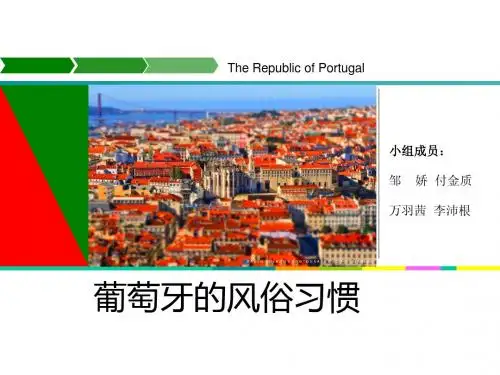
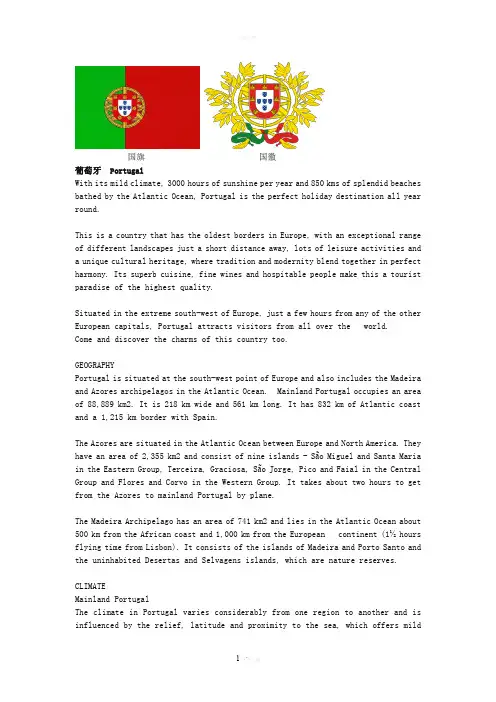
国旗国徽葡萄牙PortugalWith its mild climate, 3000 hours of sunshine per year and 850 kms of splendid beaches bathed by the Atlantic Ocean, Portugal is the perfect holiday destination all year round.This is a country that has the oldest borders in Europe, with an exceptional range of different landscapes just a short distance away, lots of leisure activities and a unique cultural heritage, where tradition and modernity blend together in perfect harmony. Its superb cuisine, fine wines and hospitable people make this a tourist paradise of the highest quality.Situated in the extreme south-west of Europe, just a few hours from any of the other European capitals, Portugal attracts visitors from all over the world. Come and discover the charms of this country too.GEOGRAPHYPortugal is situated at the south-west point of Europe and also includes the Madeira and Azores archipelagos in the Atlantic Ocean. Mainland Portugal occupies an area of 88,889 km2. It is 218 km wide and 561 km long. It has 832 km of Atlantic coast and a 1,215 km border with Spain.The Azores are situated in the Atlantic Ocean between Europe and North America. They have an area of 2,355 km2 and consist of nine islands - São Miguel and Santa Maria in the Eastern Group, Terceira, Graciosa, São Jorge, Pico and Faial in the Central Group and Flores and Corvo in the Western Group. It takes about two hours to get from the Azores to mainland Portugal by plane.The Madeira Archipelago has an area of 741 km2 and lies in the Atlantic Ocean about 500 km from the African coast and 1,000 km from the European continent (1½hours flying time from Lisbon). It consists of the islands of Madeira and Porto Santo and the uninhabited Desertas and Selvagens islands, which are nature reserves.CLIMATEMainland PortugalThe climate in Portugal varies considerably from one region to another and is influenced by the relief, latitude and proximity to the sea, which offers mildwinters, especially in the Algarve.In the Porto e Norte area and Beiras region, particularly inland, nearer Spain, the winters are colder, although the temperatures are still mild when compared to the rest of Europe. There is some snowfall. It occurs most in the Serra da Estrela mountains, where we find the highest point in mainland Portugal (1,991 m) and where it is sometimes possible to ski.The summers are hot and dry, especially in the inland areas (Trás-os-Montes in north-eastern Portugal and Alentejo). Temperatures are slightly lower in the coastal areas, because of the influence of the sea.There are often warm, sunny days in autumn. Nice weather at the beginning of November is often called "St. Martin’s Summer" as this saint’s day is on 11 November.AzoresThe climate in the Azores is influenced by the islands’ latitude and by the Gulf Stream, and temperatures are mild there all year round. The same factors also influence the sea temperature, which is very pleasant both in winter and summer and ideal for nautical sports all year round.MadeiraThe subtropical characteristics of the weather in the Madeira Archipelago can be explained by its geographical position and mountainous relief. The climate in Madeira is exceptionally mild, with average temperatures varying between 24 ºC in summer and 19 ºC in winter.The sea temperature is also very pleasant all year round, thanks to the influence of the warm Gulf Stream. It varies between 18 ºC in winter and 22 ºC in summer.POPULATIONPortugal has a population of about 10 million.The population density is at its greatest in Lisbon, the capital and its suburbs, where about 1.9 million people live. The second largest city in Portugal is Oporto in the north.Generally speaking, there are more people living in the country’s coastal regions than in the inland areas.LANGUAGEFrom a Latin root, Portuguese is spoken by about 250 million people in every continent, and is the 5th most spoken language in the world and the 3rd, if we only consider the European languages.The Portuguese-speaking countries are scattered all over the world. Portuguese is spoken in Africa (Angola, Cape Verde, Guinea-Bissau, Mozambique and São Tomé ePríncipe), in South America (Brazil) and in Asia, (East Timor, the youngest nation in the world), and it is also the official language in Macao Special Administrative Region of China.In Portugal there are lots of people who are able to communicate in English, French and Spanish.欢迎您的下载,资料仅供参考!致力为企业和个人提供合同协议,策划案计划书,学习资料等等打造全网一站式需求。